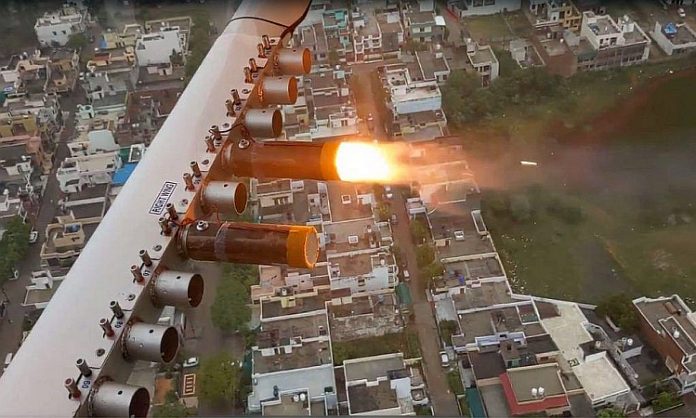Kanpur: The Indian Institute of Technology-Kanpur (IIT-K) successfully conducted a test for artificial rain via cloud-seeding over a limited area on the sprawling campus recently.
Reports said that on Wednesday, a plane flew to a height of 5,000ft from the institute’s airstrip, firing powder spray amid thick clouds, which resulted in heavy rains.
Battling with the challenges of climate change, the UP government had sought help from the premier institute (IIT-K) for this technology to help the state’s parched Bundelkhand region with artificial rains. Cloud seeding is the process of combining different kinds of chemical agents, including silver iodide, dry ice and even table salt, in clouds to thicken them and increase the chances of rainfall.
Also Read: IIT Kanpur, Reliance Life Science tie up to treat genetic eye disease
Officials at IIT-K said that the experiment was conducted after a nod from the civil aviation regulator, director general of civil aviation (DGCA).
Professor, department of computer science and engineering, IIT Kanpur, Manindra Agrawal, who is heading the artificial rain project said, “Our capabilities in this direction have been successfully tested.”
It took IIT-Kanpur six years to make this happen, after the Uttar Pradesh government reached out to help Bundelkhand with artificial rains in 2017. At that time, China had agreed to do cloud-seeding in Mahoba for ₹10.30 lakh per kilometre. But it refused to share the know-how and the plan was shelved.
Also Read: IIT Madras develops device to generate electricity from sea waves
Why did it take six years to produce artificial rains?
The moot question, however, is that why did it take IIT-Kanpur six years to produce artificial rain when the technology was available? Because it could not get a plane needed to fly the equipment with, said experts at the institute.
As the institute began preparations to produce artificial rain on UP government’s request, the stumbling block IIT-K faced was the plane, they said. The first choice was an airplane of the Indian Space Research Organisation (ISRO), which was old and not much in use. But the space agency did not agree to part with it, they added.
The IIT researchers said that they narrowed down the search to a plane of Hindustan Aeronautics Limited (HAL). “HAL asked for ₹50 lakh. The funds available at the time were meant for equipment, the condition killed the negotiations.”
Also Read: Higher use of mobile leads to rise in blood pressure: Study
Then it was decided to use IIT’s own Cessna aircraft for this purpose. The institute got in touch with US-based Cessna as the company’s assistance was required for instrumentation and fitting of the equipment on board.
Project suffered delay due to Covid19
Officials said that the project suffered delays due to outbreak of Covid pandemic. “When all seemed going on the right track, Covid-19 pandemic happened. The world stopped and so did this project for more than two and a half years,” they said, adding the last six months went into getting validation from the DGCA.
Also Read: IIT Roorkee, Taiwan firm tie up for tech solution to natural disasters
“We are now independent and have all the resources to make this project happen. Our Cessna plane and equipment will be used for cloud-seeding,” said prof Manindra Agrawal.
Project meant for artificial rains in Bundelkhand
Chief minister Yogi Adityanath had envisaged the plan for artificial rain in Bundelkhand as the technology was not only low on cost but also effective. Bundelkhand region has a vast cultivation area, but the agriculture production is determined by the availability of water.
Bundelkhand has four rivers including Dhasan, Tons, Betwa and Ken but they are of little use for irrigation purpose. The region gets scanty rainfall due to which most of the water bodies such as ponds dry up, and remain so most of the year.
IIT-K launched project after China refused to share tech
After China’s refusal for the project, IIT-Kanpur scientists had given a detailed presentation to the government on June 26, 2017 to help with pollution and drought-like conditions.
Also Read: UIDAI-IIT-B tie up to develop touchless biometric capture system
Member of national advisory council on environment and senior IIT Kanpur faculty Sachidanand Tripathi explained that the use of aircraft and essential tools for the cloud seeding process raise the cost of the project. The rent of the plane fitted with equipment is high and implanting instruments in the aircraft is also an expensive affair. Roughly ₹2 to ₹5 lakh is spent for an hour of the exercise, he added.
Artificial rain tried in other states but with little success
Artificial rain was created in Maharashtra, Karnataka and Andhra Pradesh, but the success rate of the project isn’t yet known, said Tripathi. Israel, South Africa and United States have successfully implemented the project. The rains created artificially do not have any adverse impact on the environment. The solutions used for cloud seeding are not harmful, said experts.




